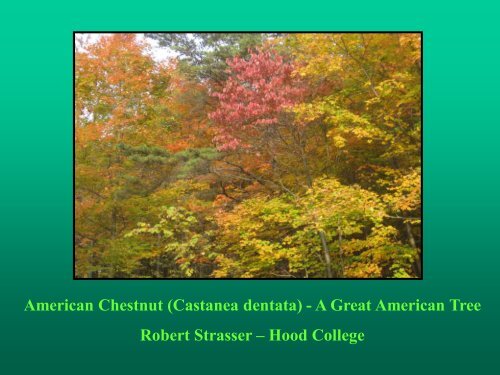American Chestnut (Castanea dentata) - A Great American Tree ...
American Chestnut (Castanea dentata) - A Great American Tree ...
American Chestnut (Castanea dentata) - A Great American Tree ...
Create successful ePaper yourself
Turn your PDF publications into a flip-book with our unique Google optimized e-Paper software.
<strong>American</strong> <strong>Chestnut</strong> (<strong>Castanea</strong> <strong>dentata</strong>) - A <strong>Great</strong> <strong>American</strong> <strong>Tree</strong>Robert Strasser – Hood College
<strong>American</strong>chestnut leavesturn goldenbrown inAutumn.
<strong>Chestnut</strong> flowering in early summer in the Blue Ridge.
The Appalachian mountains are the coreof the species’ natural range.
Domain – EukaryaKingdom – PlantaePhylum – AnthophytaClass – DicotyledonesOrder – FagalesFamily – FagaceaeGenus – <strong>Castanea</strong>Species - <strong>dentata</strong>FungiEubacteriaPlantaeAnimaliaPro tistaArchaebacteriaHow chestnutfits amongliving things:Origins of Life > 3.5 BYA
Beech family (Fagaceae) : Beech (Fagus) and Oak(Quercus) and <strong>Chestnut</strong> (<strong>Castanea</strong>)1. Chinese – <strong>Castanea</strong> mollissima2. Japanese – <strong>Castanea</strong> crenata3. European – <strong>Castanea</strong> sativa4. <strong>American</strong> – <strong>Castanea</strong> <strong>dentata</strong>• Four other <strong>Castanea</strong> species – chinquapins in North America• Many can hybridize<strong>Chestnut</strong> Classification
Evolutionary Migration Pathway – <strong>Castanea</strong>•Chloroplast DNA sequences suggest a common <strong>Castanea</strong> ancestor originatedin Laurasia about 40 – 60 million years ago. C. <strong>dentata</strong> probably diverged from C.sativa in the late Eocene epoch – approximately 35 million years ago.
Leaf Identification (L to R): <strong>American</strong> <strong>Chestnut</strong> (C. <strong>dentata</strong>), Chinese<strong>Chestnut</strong> (C. mollissima), Chinkapin (C. pumila), European <strong>Chestnut</strong> (C.sativa), and Japanese <strong>Chestnut</strong> (C. crenata).
Twigs and Buds,Left – Right:<strong>American</strong>ChineseEuropeanJapanese
<strong>Chestnut</strong>s (Left – Right): <strong>American</strong>, Chinese, Japanese, European
<strong>Chestnut</strong>s make nice shade trees.
<strong>American</strong> chestnutswere abundant andcould reach very largesizes.
<strong>Chestnut</strong> was a versatile hardwood quite valuable to rural <strong>American</strong> life.
<strong>American</strong> <strong>Chestnut</strong>‟sDiverse Uses:•Fencing•Telegraph poles•Railroad ties•Shingles and siding•Framing lumber•Furniture•Heavy timber contstruction•Tanin production•Charcoal•Fuel•Food
AbrahamLincoln“Fence Splitter”
Approximately 600,000,000board feet of chestnut lumberwas cut in 1909, bringingabout $10,000,000 to theeconomy of Appalachia.<strong>Chestnut</strong> wood harvests inthe US peaked between1907 and 1910.
Many good foods can be made with chestnuts.
Wildlife thrived on <strong>American</strong> chestnuts.
Late 1800’s -Blight PandemicBegan• Parasitic fungus - Cryphonectria parasitica• Enters bark and infects cambium, not roots• Rapid, uncontrollable dispersal
An estimated 3-4 billion <strong>American</strong> chestnuts grew at beginningof the blight pandemic, and most died within 50 years.
Ridges dominated by chestnut were devastated.
Spread ofCryponectriaparasitica
Biology of Cryphonectria parasitica :• Infections are perennial• Reproduce asexually and sexually via spores• at least 64 different strains
Point ofEntrySwellingCankerSunken Canker
Blight infects trees of all ages and sizes, not always killing them quickly.6 Months ~ 6 Years > 20 years
<strong>Chestnut</strong> survives by growing slowly in the shade.
ForestUnderstoryShenandoahNational Park
Surviving C. <strong>dentata</strong>Rolling RidgeFoundationHarper‟s Ferry, WV
LaMonica <strong>Tree</strong>Marshal, VirginiaJanuary 2008
Jim Hill‟s <strong>Tree</strong> (#6546)Height 85 feetDiameter 13 inchesMt. Airy, Maryland
Evil Tendendencies CancelWill the blight end the chestnut?The farmers rather guess not.It keeps smoldering at the rootsAnd sending up new shoots.„Till another parasiteShall come and end the blight.-Robert Frost (1936)
Uninfected BarkIs this resistanceor hypovirulence?Non-leathal Canker
Hypovirus in vitro – Blight Strain EP155Hypervirulentno virusHypovirulentvirulent virusHypovirulentweak virus
Anastomosis:fusion of fungalhyphae• Cytoplasmic exchange between individuals• Viral RNA can transmit hypovirulence between strains
Compatible blight strains:• Anastomosis possible• Viral transmission possibleIncompatible blight strains:• No anastomosis• No viral transmission
The <strong>American</strong> <strong>Chestnut</strong> Foundation – Founded 1983Beginning in 1987, TACF initiated a systematic program toincorporate blight resistance found in Asian chestnuts into the<strong>American</strong> chestnut through backcross breeding.
Chinesechestnut resistsblight, but issmaller instature.
<strong>American</strong>chestnutgrows tall andstraight…butis susceptibleto blight.
TACF‟s BackcrossBreeding ProgramChineseX<strong>American</strong>Each generation select for: Blight resistance <strong>American</strong> characteristicsF 1 ½ <strong>American</strong> (50%)BC 1 ¾ <strong>American</strong> (75%)XX<strong>American</strong><strong>American</strong>Final Product: goal is truebreeding<strong>American</strong> typewith a high levelof blight resistanceBC 2 7 / 8 <strong>American</strong> (88%)BC 3 15 / 16 <strong>American</strong> (94%)XX<strong>American</strong>BC 3BC 3 F 2 15 / 16 <strong>American</strong> (94%)XBC 3 F 2BC 3 F 3 15 / 16 <strong>American</strong> (94%)
RR x rr = Rr (F 1 )Rr x rr = Rr and rr (BC 1 )Rr x rr = Rr and rr (BC 2 )Rr x rr = Rr and rr (BC 3 )Rr x Rr = RR, Rr and rr (BC 3 F 1 )RR x RR = RR (BC 3 F 2 )RR x RR = RR (BC 3 F 3 )Proposed genetics of blight resistance:R = Resistance factor (Chinese)r = recessive allele (<strong>American</strong>)
Dr. Hill Craddock with an intercross chestnut near Chattanooga, TN.
What are we looking for in ourbackcross chestnuts?• Blight and other disease resistance• <strong>American</strong> phenotype• Genetic diversity
Pollination inthe field ofteninvolves theuse of bigladders andbucket trucks.
Controlled Pollination<strong>Chestnut</strong>s are amonoecious species:They have both maleand female flowers onall trees.
Staminate Catkins – Male Flowers Only
Bisexual Catkins – Both Female and Male Flowers
Trimming catkinsto leave onlyimmature femaleflowers.
Receptive flowers arefertilized with dried pollenfrom selected father trees.
Pink ribbons mark unpollinated check (control) bags.
Burs become heavy in late summer.
Late September – Burs Open
Left: pollinated bur.Right: Un-pollinated bur.
Screening <strong>Chestnut</strong>s for BlightResistance: Paired Inoculations1. <strong>Tree</strong>s are infected with two strains of blight:• EP 155 – highly virulent• SG 2 3 – moderately virulent2. Cankers evaluated after 12 months• Large cankers – poor resistance• Small cankers – better resistance
Resistance: ability to limit the spread of disease.Immune --- Resistant ---SusceptibleBlight resistance in chestnut is ranked numerically:1 - - - - - 2 - - - - - 3 - - - - - 4 - - - - - 5Strong - - - Good - - - Moderate - - - Poor - - - None
Inoculation of3 Year Old<strong>Chestnut</strong>sWith Blight2) Insert cultures1) Bore hole in cambium3) Seal with tape
Paired Inoculations1 year post-inoculationResistance Rating: 5<strong>Castanea</strong> <strong>dentata</strong>SG 2 3EP 155EP 155
ThorpeWood <strong>Tree</strong> 50 – Backcross 1Inoculated June 2004 - Resistance Rating: 2.5SG 2 3SG 2 3EP 155EP 155June 2005 June 2006Jan 2008
…but trees withenough blight resistanceare advanced bybreeding them again.Blight susceptible treesare cut down…
How can you get involved?• Join the <strong>American</strong> <strong>Chestnut</strong> Foundation• Help plant, pollinate, and care for trees• Pursue research to advance science
www.acf.orgwww.vatacf.org


